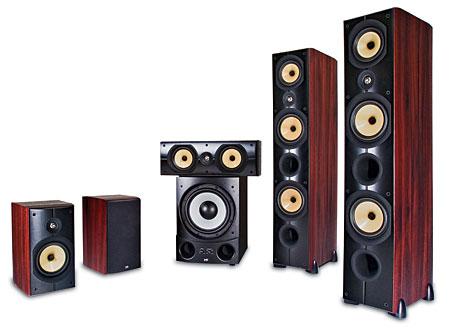PSB Image T6 Speaker System

More for Less
The new Image line of speakers from Canadian manufacturer PSB follows on the heels of two other PSB ranges: Synchrony and Imagine. While they aren’t exactly blue-light specials, the Images provide an intangible quality that today’s speaker buyer demands: value. And with the increasing costs of domestic manufacturing, value most often means overseas production. All of PSB’s new models, including the Imagines, are engineered in Canada but made in China. This is an increasingly common practice in the speaker industry.
Description
The Image line consists of eight models: two floorstanders, three monitors, two centers, and a dedicated surround. The system reviewed here includes the largest floorstander, the Image T6; the largest monitor, the Image B6; and the largest center, the Image C5. To fill out the package, PSB also sent me the SubSeries 5i subwoofer.
The woofer and midrange drivers throughout the Image lineup employ clay/ceramic-filled polypropylene cones. The woofers are all long throw, and the 1-inch titanium-dome tweeter is the same tweeter that appears in the Synchrony line. All of the crossovers are third or fourth order at 500 hertz and 2.2 kilohertz in the three-way Image T6 and 1.8 kHz in the two-way Image B6 and Image C5. Each speaker has two pairs of terminals for biwiring, if desired. I left the shorting straps in place and single-wired the speakers.
The cabinet quality of all the Image models is exceptional for the price level. The finish is vinyl and not real wood veneer, but you wouldn’t guess it. The vinyl doesn’t just look like the real thing (particularly the Dark Cherry option), it feels like it as well. It effectively simulates the touch of real wood. A gentle tapering at the front and back cabinet edges (barely visible except in close-up) further enhances the real-wood effect. It gives the speakers far more visual character than your average rectangular boxes. The rounded, black-finished front baffles and molded trim rings around the drivers top off the speakers’ uniquely attractive appearance. I liked how the speakers looked without the removable grilles, so I did all of my listening that way. You may be less smitten than I was by the high-tech look of exposed domes and cones.
The only downside here is that the Image T6’s narrow cabinet and relatively light weight of 48 pounds make it a bit unstable. A gentle nudge won’t push it over, but it might give you a moment of panic, particularly if there are rugrats lurking about.
The SubSeries 5i subwoofer’s active ingredients include a 10-inch polypropylene-coned woofer and a 150-watt continuous (225 watts dynamic, 450 watts peak) Class H/BASH amplifier. PSB provides both line-level inputs and speaker-level inputs/outputs. It also includes switches for phase (0 and 180 degrees) and bypass for the built-in low-pass filter (selectable from 50 to 150 Hz). Filter adjustment and level controls are conveniently located on the front of the sub.

The speaker-level outputs from the SubSeries 5i to the main left and right speakers are always full range—the SubSeries 5i doesn’t have high-pass filters. But speaker-level connections are mainly a convenience for use in a two-channel system that needs a subwoofer but lacks a line-level subwoofer output. I used the SubSeries 5i’s line-level input, which is the preferred connection for most home theater setups.
Setup
I set up the Image T6 speaker system in my usual 26-by-15.5-by-8-foot home theater studio. I placed the Image T6s about 9 feet apart to the left and right of my projection screen. Then I toed them in toward the main listening position. (I retract the projection screen for music listening.) I positioned the center speaker on a low stand below the screen. I didn’t biwire or use spikes (in the latter case, I did this so I wouldn’t mar the oak flooring under the near room-filling area rug). The speakers were driven by a Parasound Halo A 51 power amp and an Integra DTC-9.8 surround processor. Sources included the Pioneer Elite BDP-09FD and Marantz BD7004 Blu-ray players. For music, I connected the Integra via coaxial digital; for movies, I used HDMI. Audio cables included vintage designs from Monster Cable, Cardas Audio, and Kimber Kable.
- Log in or register to post comments





































































